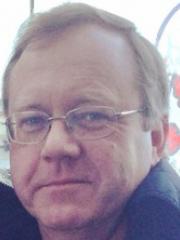
Tony Webster has spent over 30 years as a geoscientist in the mining industry, government and universities; working mainly on base metal, gold and iron ore deposits.
He has had a varied career spanning research, higher education, geotechnical, production, resource definition, exploration, heritage and environmental roles. He has particular skills in structural geology applied to mining and exploration, and in the geological interpretation of complex mineralised systems.
As a research fellow in mining and engineering geology, Tony's current research is focussed on the geological modelling and data inputs required for planning deep cave mining operations, an area that has received little previous consideration from geologists. He is working with PhD student, Matthias Klawitter, and the School of Earth Sciences to develop remote geological mapping and structural modelling methods that are based on 3D imagery (photogrammetry). The primary aim of this work is to understand 'natural solution collapse breccia pipes' exposed in canyon walls in northwestern Arizona. These features may be natural analogues of block caving mine subsidence zones. The understanding of the natural systems, achieved through 3D modelling and analysis, will increase knowledge of mine caving processes. Attention will then be focussed on the applications of the methodology to problems such as the geotechnical management of open pit mines, and civil engineering projects.
Much of Tony's work has been focussed on understanding the lithostructural architecture of a variety of deposits, and deposit styles, including porphyry Cu (block caving) • IOCG (sublevel caving) • Hamersley Type iron deposits • Savage River magnetite deposit • Broken Hill Pb Zn Ag (BHT) • Potosi Zn Pb Ag deposit (BHT) • Elura Zn Pb deposit • Hercules Pb Zn Ag Au Cu (VHMS) • Zeehan silver lead (tin) field • Prairie Downs Zn deposit (east Pilbara) • Hampton-Boulder Au deposit, and the northern end of the Kalgoorlie Golden Mile.
Tony's research interests extend to the history and archaeology of Australian mining, and historic landscape and environmental reconstruction - focussed on the inner urban areas of Australia's major cities - where he is reconstructing the landscapes encountered by the first European settlers. He is discovering how the underlying geology of Australia's inner cities influenced their settlement and development patterns and gives them much of their unique character. Tony has completed many industrial archaeological site surveys in-advance of exploration drilling and mine redevelopments, and provided assesments of their likely impact to both government and company clients. He has also been a member of teams involved in the rehabilitation works on historic mine sites.
Tony believes that communicating research to undergraduates, postgraduates and industry professionals is almost as important as doing the work itself. He has designed and managed advanced level geoscience training courses, particularly with a field-component, and has run many short-courses, seminars and symposia. Tony is particularly keen to provide better support to RHD's from non-English speaking backgrounds.
Tony is an associate editor of the Australian Journal of Earth Sciences and is active in a number of learned societies and professional Institutes.
- Fellow of the Australasian Institute of Mining and Metallurgy (CP) - currently a member of the Committee of the Geoscience Society.
- Fellow of the Society of Economic Geologists
- Member, Geological Society of Australia - currently Chair of the Queensland Division.
- Fellow of the Geological Society
- Member, SGA
- Member, Geoscience Society of New Zealand
- Member, Australasian Society for Historical Archaeology.
